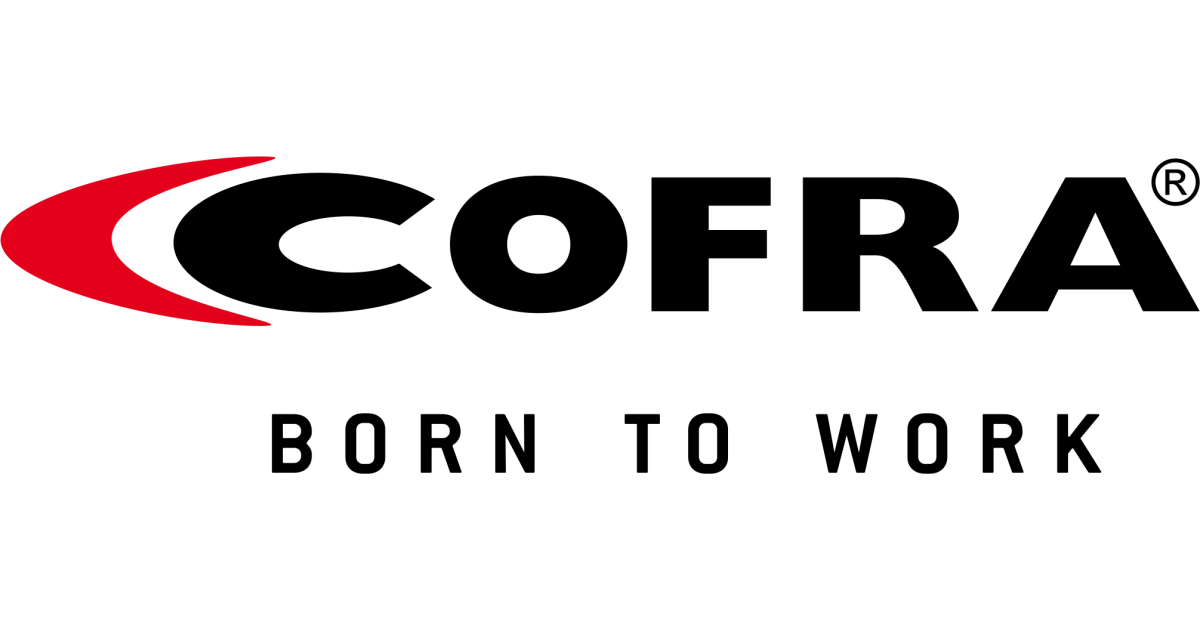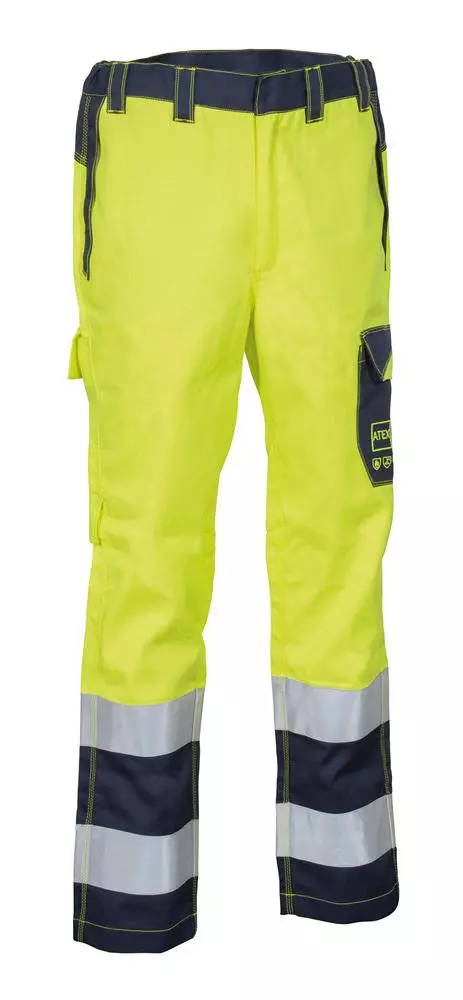Cofra Charring Work Pants Yellow/Navy
Cofra Deutschland
visit storeProduct description
Standards:
- EN 1149-5:2018
- EN 13034:2005+A1:2009
- EN ISO 11611:2015
- EN ISO 11612:2015
- EN ISO 13688:2013
- EN ISO 20471:2013/A1:2016
- IEC 61482-2:2018
Product Features:
- Two back pockets
- Two front pockets
- Triple stitching at high-stress points
- Ergonomic knee design
- Flame-retardant reflective tapes
- Recommended for ATEX environments
- Embroidered pictogram on side pocket
- Side pocket
- YKK® zippers
- Ruler pocket
- "ATEX" embroidery on side pocket
- Type: Men's
- Performance E Plus: Not detectable by metal detectors
Technical Details:
- Fabric Composition: 75% cotton, 24% Polyester, 1% carbon
- Weight: 260 g/m²
Areas of Application:
- ATEX environment
- Chemical and petrochemical industry
- Chemical protection
- Railway industry
- Flame-retardant environments
- Airports
- Gas and electricity supply
- High visibility environments
- Industry
- Maintenance and installation of electrical systems
- Metal and steel industry
- Offshore oil platforms
- Welding
Describes special features on the leg portion such as reflective stripes or side zips that enhance safety, accessibility, and functionality in work environments.
Measured in grams per square meter (g/m²), indicating fabric thickness and durability. Higher values offer more protection and longevity in demanding work environments.
- Welding
- Chemical Resistance
- Heat & Flame Resistance
- High Visibility
- Electrical Protection
- Machine Washable
Request a free sample
Test first and buy later. Visit any product page to request your free sample.
Standards and labels
EN 1149-5:2008 is a European standard that specifies the requirements for electrostatic dissipative (ESD) gloves. The standard defines performance requirements for material, design, and testing of ESD gloves. The gloves must be able to effectively discharge static electricity and protect the wearer from ESD. Testing includes measuring the surface resistance of the glove material. Pass/fail results are based on the gloves meeting or not meeting the specified requirements.
Test results
Material Performance TestedThe EN 1149-5:2008 standard specifies the performance requirements for material used in protective clothing designed to avoid incendiary discharges. The test result Tested means that the material has undergone relevant evaluation procedures to confirm its static dissipative properties. These tests generally involve measuring the electrical resistance of the material in ohms (Ω) to determine its capability to dissipate electrostatic charges and prevent sparking that could ignite flammable substances. The practical implications of this result for the respective product category (like protective workwear for use in explosive atmospheres) are significant, as it ensures that the clothing provides a level of protection against electrostatic discharges, potentially reducing the risk of fire or explosion in environments with flammable gases, vapors, or dusts.
EN 13034:2005 is a European standard that specifies the requirements and test methods for Type 6 protective clothing designed to provide protection against liquid chemicals. This standard sets criteria for the fabric's resistance to penetration by liquid chemicals and establishes guidelines for the overall design and construction of the clothing. It ensures that Type 6 protective clothing offers reliable protection for workers in industries where they may be exposed to liquid chemical hazards, but it may not be suitable for protection against airborne particles.
Test results
Liquid Chemical Protection Type 6EN 13034:2005 specifies the requirements and test methods for protective clothing that provides limited protection against liquid chemicals, designated as Type 6. The 'Type 6' classification indicates that the clothing has been tested and found capable of resisting light spray and minor splashes of liquid chemicals. This test method assesses the fabric's ability to prevent penetration from a synthetic blood solution sprayed at the garment at different angles and pressures, simulating realistic conditions where accidental chemical splashes might occur. Protective clothing that achieves this classification is essential for workers in industries such as chemical manufacturing, painting, or pesticide application, where there is a risk of exposure to harmful liquids but full immersion is not expected, thus enhancing worker safety by providing sufficient protection in low-volume chemical exposure scenarios.
EN 11612:2015 is a European standard that specifies the requirements for protective clothing against heat and flame. This standard defines performance requirements for material, design, and testing of clothing that protects the wearer from heat and flames. Testing includes measuring the clothing's resistance to heat and flame, as well as its ability to self-extinguish. Pass/fail results are based on the clothing meeting or not meeting the specified requirements.
EN 11611:2015 is a European standard that specifies the requirements for protective clothing for use in welding and allied processes. This standard defines performance requirements for material, design, and testing of clothing that protects the wearer from heat and flames. Testing includes measuring the clothing's resistance to heat and flame, as well as its ability to self-extinguish. Pass/fail results are based on the clothing meeting or not meeting the specified requirements.
Test results
Welding Protection Class 1The standard EN 11611:2015 establishes criteria for protective clothing used during welding and allied processes, specifically regarding safety to reduce the risk of harm from sparks, spatter, and other hazards associated with welding. In this context, a Class 1 test result indicates the clothing provides basic protection suitable for less hazardous welding techniques where lower levels of spatter and radiant heat are anticipated. The test for this classification involves subjecting the fabric to controlled ignition and monitoring its resistance to flame spread, heat transfer, and the formation of holes. The fabric material must neither ignite nor continue to burn after the source of ignition is removed. In practical terms, products achieving Class 1 under EN 11611:2015 are suitable for types of welding that produce lower spatter and radiant heat, making them ideal for less intense welding operations but not for those that involve higher risks that might require more robust protective gear categorized in higher classes.
EN 13688:2013/A1:2021 is an amendment to the European standard EN 13688:2013 that specifies the performance requirements for protective clothing. The standard includes requirements for safety, comfort, and durability, as well as tests for determining these properties. Protective clothing includes items like coveralls, aprons, and gloves that are worn to protect the wearer from hazards. The amendment updates the standard to include new test methods and performance requirements. Possible test results include resistance to chemicals, heat, abrasion and tearing, as well as breathability and comfort. The clothing can be tested under different conditions to check if it meets the standard's requirements.
Test results
Reflective Strip Area Grade 3The EN ISO 20471:2013 standard specifies the requirements for high-visibility clothing, with a specific focus on the reflective strip area, a crucial element for ensuring visibility in low-light conditions. A test result achieving Grade 3 indicates the highest level of reflectivity performance in this standard, ensuring optimal visibility and safety for the wearer in various lighting conditions. In grade 3 products reflective tape is 0.20 m2 and fluorescent material is 0.8 m2.The test methodology involves assessing the amount and quality of retroreflective material on garments. This is quantified under precise conditions to ensure that the reflective strips meet stringent visibility requirements even from significant distances or in poor lighting conditions. Garments that meet Grade 3 requirements are suitable for use in high-risk environments where being seen by others is crucial for safety, such as road construction sites, airport ground operations, and other scenarios with high vehicular traffic or complex visual backgrounds.
CE Marking is a label that shows a product meets certain safety and environmental standards set by the European Union. To get the CE Marking, a company must test and certify their product meets these standards. CE Marking is required for many products sold in the EU, including electronics, machinery, toys and medical devices. It helps ensure that products are safe for consumers and the environment, and allows for easy trade within the EU.
Oeko-Tex Standard 100 is a product certification program for textiles, which is awarded by the Oeko-Tex Association. This program verifies that the textile products are free from harmful chemicals. To be able to use the Oeko-Tex Standard 100 label, a product must meet certain requirements set by the Oeko-Tex Association which include limits on the levels of harmful substances such as pesticides, heavy metals, and formaldehyde. The textile products are inspected and certified by Oeko-Tex, they can use the Oeko-Tex Standard 100 label on their packaging to show that they are free from harmful chemicals. This certification is for all types of textiles, from raw materials to finished products, and it is globally recognized.
PPE stands for "personal protective equipment." PPE Category 3 refers to equipment that is complex and provide the highest level of protection such as powered respirators, SCBA, and full body suits. In Europe, PPE Category 3 must meet certain safety standards set by the European Union, which means that it must be designed and manufactured to protect the user without causing harm. Companies that make or sell PPE must prove that it meets these standards. They also must have a quality management system in place, have to be audited regularly by a notified body and have to have a technical documentation.
Cofra Deutschland delivery terms
Free delivery when you order more than 150,00 € from Cofra Deutschland
Supplier shipping fee 6,68 €
Brand minimum 0,00 €
68,75 €
Shipping fee is 6,68 € for orders under 150,00 €
Sold in units of one piece
Need larger quantities?
Other products you may like
Recently viewed
Need help?
Get help from our experts
Other products you may like
Similar products you may like
Recommended for you
Cofra Deutschland
Delivery time: 3 business days
Supplier shipping fee 6,68 €
Free shipping on orders over 150,00 €



Find +150,000 products from hundreds of brands
Autonomous sourcing platform
The most efficient way to source and order supplies for your operations
Sourcing
Ordering
List products you’re looking for and we’ll find the best products and prices for you – all for free.
Need help?
Get help from our experts
